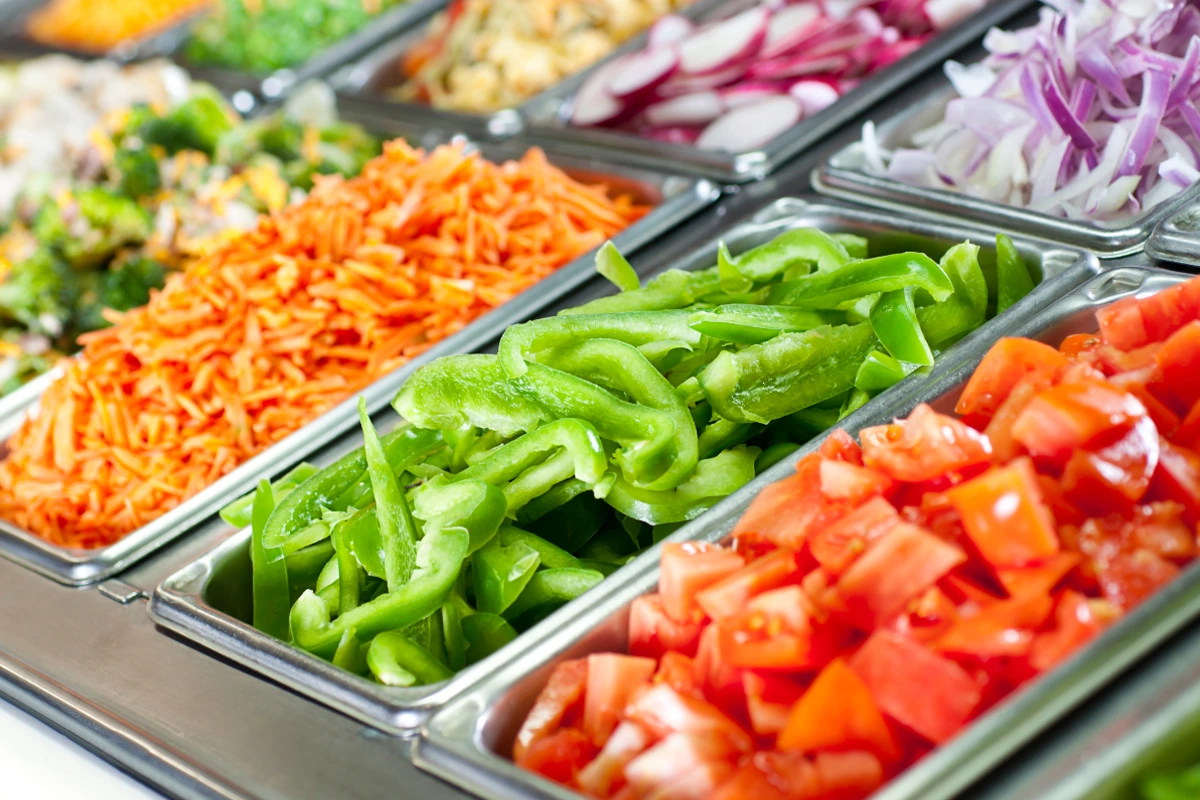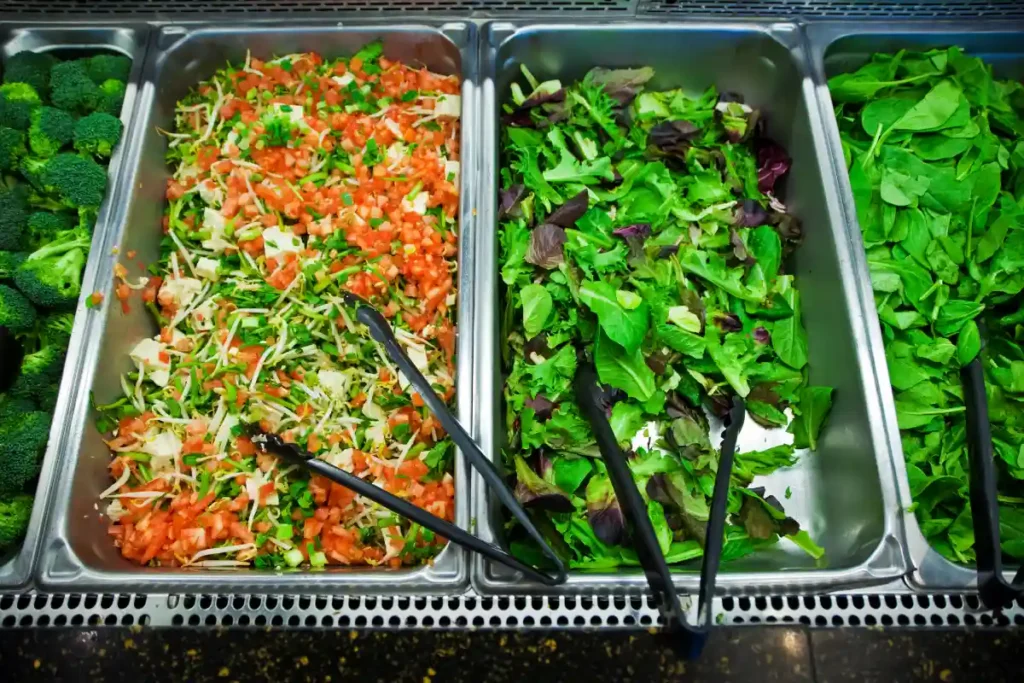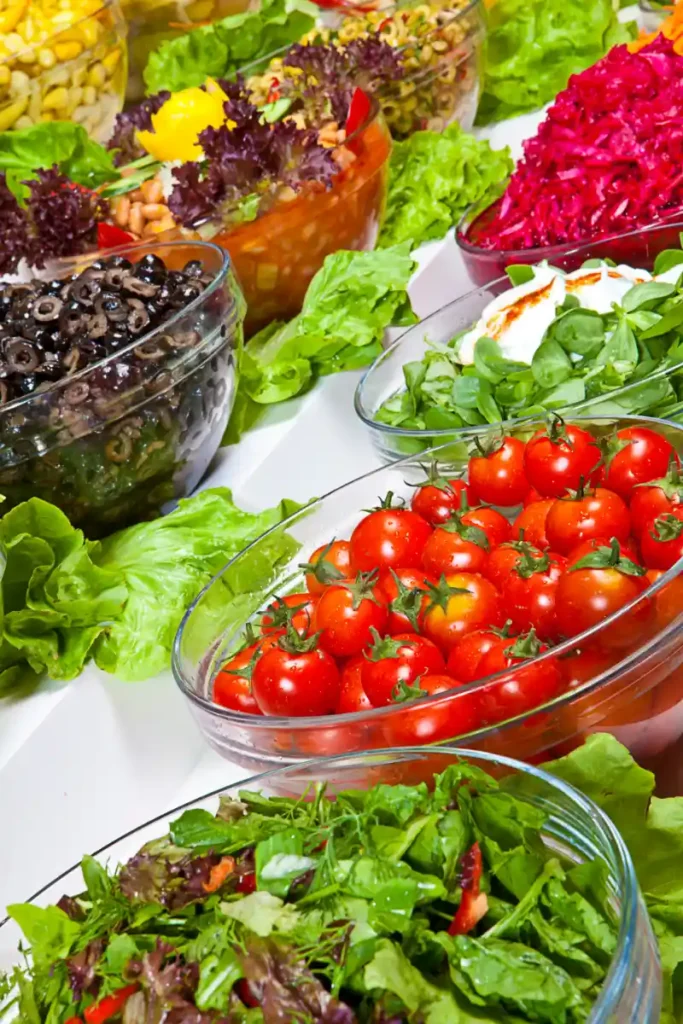The humble salad bar – a seemingly simple concept that has revolutionized the way we approach healthy eating. From vibrant displays of fresh produce to endless customization options, salad bars offer a unique and interactive dining experience. Whether you’re a seasoned salad enthusiast or just starting your journey toward a healthier lifestyle, this comprehensive guide will delve into everything you need to know about salad bars. We’ll explore their history, benefits, essential ingredients, tips for building the perfect salad, and even etiquette for navigating these bountiful buffets. So, grab a plate and join us as we embark on a delicious exploration of the wonderful world of salad bars!
Salad Bar Basics
What is a Salad Bar?
At its core, a salad bar is a self-serve station offering a variety of ingredients for creating customized salads. Picture this: a colorful array of fresh vegetables, crisp greens, protein options, cheeses, nuts, and dressings – all laid out for you to pick and choose according to your preferences. Salad bars can range from simple setups with basic ingredients to elaborate displays boasting exotic fruits, gourmet cheeses, and a plethora of dressings and toppings. They are commonly found in restaurants, cafeterias, grocery stores, and even homes, providing a convenient and healthy way to enjoy a balanced meal.
The History of Salad Bars
Believe it or not, the concept of the salad bar has been around for quite some time. Its origins can be traced back to the early 20th century when salad bars started appearing in upscale hotels and restaurants. However, it wasn’t until the 1960s and 70s that they truly gained popularity, becoming a staple in casual dining establishments and cafeterias. This rise in popularity coincided with a growing awareness of health and nutrition, as people began to seek out fresh and wholesome food options.
Over the years, salad bars have evolved significantly, adapting to changing tastes and dietary trends. Today, we see a wide range of salad bar concepts, from traditional self-serve stations to made-to-order options where salads are assembled by staff. Additionally, the variety of ingredients has expanded to include international flavors, organic produce, and options catering to specific dietary needs.
Benefits of Salad Bars
The appeal of salad bars extends far beyond their visual appeal. These self-serve stations offer numerous benefits that make them a popular choice for health-conscious individuals and busy folks alike.
- Nutritional Powerhouse: Salad bars provide an excellent way to pack in essential nutrients, vitamins, and minerals. With a diverse selection of fresh produce, lean proteins, and healthy fats, you can easily create a balanced and nutritious meal that supports your overall well-being.
- Customization King: One of the greatest advantages of a salad bar is the ability to personalize your salad to your exact liking. Whether you prefer a classic Caesar or a more adventurous combination of flavors, the options are endless. This level of customization allows you to cater to your taste buds and dietary needs, ensuring a satisfying and enjoyable experience.
- Convenience on a Plate: In today’s fast-paced world, convenience is key. Salad bars offer a quick and easy way to enjoy a healthy meal without spending hours in the kitchen. Simply select your desired ingredients, toss them together, and voilà – a delicious and nutritious meal is ready in minutes.
- Value for Money: Salad bars often provide a cost-effective way to enjoy a variety of fresh ingredients. Compared to ordering individual salads, salad bars typically offer a more affordable option, especially when you consider the wide selection of toppings and dressings available.
Building the Perfect Salad Bar
Essential Ingredients
Creating a well-rounded and enticing salad bar requires careful consideration of the ingredients. The key is to offer a diverse selection that caters to different tastes and dietary preferences. Here are some essential components to include:
- Base Greens: The foundation of any great salad lies in the greens. Offer a variety of options such as crisp romaine lettuce, tender spinach, nutrient-rich kale, peppery arugula, and even mixed greens for a blend of flavors and textures.
- Vegetables: A colorful assortment of vegetables adds visual appeal and essential nutrients to your salad bar. Popular choices include juicy tomatoes, crunchy cucumbers, sweet bell peppers, grated carrots, broccoli florets, and red onions. Don’t forget to consider seasonal options like fresh corn, asparagus, or zucchini for a touch of variety.
- Fruits: Adding fruits to your salad bar brings a burst of sweetness and a refreshing twist. Consider offering classic favorites like strawberries, blueberries, grapes, and apples, as well as more exotic options like mango, pineapple, or kiwi.
- Proteins: To make your salads more satisfying and protein-rich, include a variety of protein sources. Grilled chicken, flaked tuna, boiled eggs, tofu cubes, chickpeas, and black beans are all excellent options that cater to different dietary needs.
- Cheeses: Cheese lovers rejoice! A selection of cheeses adds richness and flavor to your salad bar. Offer a variety of textures and flavors, such as crumbled feta, shredded cheddar, mozzarella pearls, or even creamy blue cheese.
- Nuts and Seeds: For added crunch and a boost of healthy fats, include a selection of nuts and seeds. Almonds, walnuts, pecans, sunflower seeds, and pumpkin seeds are all popular choices that enhance both the taste and nutritional value of your salads.
Dressings and Toppings:
No salad bar is complete without a tempting array of dressings and toppings. Offer classic options like vinaigrette, ranch, and Caesar dressing, as well as lighter choices like balsamic vinegar and olive oil. For toppings, consider croutons, crispy wonton strips, bacon bits, and a variety of herbs and spices.
Choosing Fresh and Quality Produce
The success of your hinges on the quality of your ingredients. Fresh, flavorful produce not only tastes better but also provides optimal nutritional value. Here are some tips for selecting the best ingredients:
- Seasonal Sensations: Opt for seasonal fruits and vegetables whenever possible. They tend to be fresher, tastier, and more affordable, as they are grown locally and harvested at their peak ripeness. Visit your local farmers’ market or check with your grocery store to see what’s in season.
- The Art of Selection: When choosing produce, look for vibrant colors, firm textures, and a fresh aroma. Avoid items that appear wilted, bruised, or have any signs of spoilage.
- Storage Savvy: Proper storage is crucial for maintaining the freshness of your ingredients. Store greens and vegetables in the refrigerator, preferably in airtight containers or bags. Fruits can be stored at room temperature until ripe, then transferred to the refrigerator.
Creative Salad Bar Ideas
Thinking outside the box can elevate your salad bar from ordinary to extraordinary. Here are a few creative ideas to inspire you:
- Theme-Based Adventures: Transport your taste buds to different corners of the world with theme-based salad bars. Explore the flavors of the Mediterranean with olives, feta cheese, and oregano, or embrace the vibrant tastes of Asia with edamame, mandarin oranges, and a sesame ginger dressing.
- Dietary Delights: Cater to specific dietary needs by offering options for vegan, gluten-free, or keto diets. This ensures that everyone can enjoy the deliciousness of your salad bar without compromising their dietary restrictions.
- Interactive Fun: Create a sense of engagement with a build-your-own salad bar concept. Provide recipe cards with suggested ingredient combinations or allow guests to name their unique creations. This adds a touch of fun and personalization to the experience.
Salad Bars in Different Settings
Restaurants and Cafeterias
Salad bars have become a ubiquitous feature in many restaurants and cafeterias, offering a convenient and healthy option for diners. They can serve as a main attraction, providing a complete meal solution, or as a side dish option to complement main courses.
Restaurants often implement different pricing models for their salad bars. Some may offer a fixed price for unlimited servings, while others may charge by weight or based on the number of ingredients selected. Buffet-style setups are common, allowing diners to browse and choose their desired ingredients at their own pace.
Salad bars also play a significant role in catering services and events. Many restaurants offer catering packages that include a customized salad bar to suit the occasion and dietary needs of the guests. This provides a flexible and crowd-pleasing option for weddings, corporate events, and social gatherings.
Grocery Stores and Supermarkets
Grocery stores and supermarkets have also embraced the salad bar concept, providing busy shoppers with convenient and healthy meal solutions. Pre-packaged salad options are readily available, offering a quick grab-and-go solution for those short on time.
Many grocery stores also feature salad bar stations where customers can create their salads from a wide selection of fresh ingredients. These stations often cater to health-conscious consumers by offering organic and locally sourced produce, as well as a variety of dressings and toppings to suit different preferences.
The rise of online grocery shopping has further extended the reach of salad bars. Many supermarkets now offer online ordering and delivery services, allowing customers to enjoy the convenience of a salad bar from the comfort of their own homes.
Home Salad Bars
Bringing the salad bar experience into your kitchen is a fantastic way to promote healthy eating habits and encourage culinary creativity. By setting up a dedicated space with a variety of ingredients, you can create a personalized salad bar that caters to your family’s preferences.
Start by investing in a few key storage containers to keep your ingredients fresh and organized. Airtight containers are ideal for storing greens and vegetables, while separate containers can be used for fruits, proteins, and toppings.
Consider prepping certain ingredients in advance to save time during busy weeknights. Chopping vegetables, grilling chicken, and cooking grains ahead of time can make assembling salads a breeze. This is also a great way to encourage healthy meal prepping and ensure you have nutritious options readily available.
Tips and Tricks for Salad Bar Success
Salad Bar Etiquette
Navigating a salad bar can be a delightful experience, but it’s important to follow proper etiquette to ensure a pleasant experience for everyone. Here are a few key guidelines to keep in mind:
- Hygiene Hero: Always use the provided utensils and avoid touching the ingredients directly. This helps maintain hygiene and prevent the spread of germs.
- Respectful Sharing: Be mindful of other users and avoid taking excessive amounts of any one ingredient. Remember, there’s plenty of deliciousness to go around!
- Waste Warrior: Take only what you intend to eat to minimize food waste. It’s better to start with smaller portions and go back for seconds if needed.
- Efficiency Expert: Plan your salad before you start filling your plate. This will help you navigate the salad bar efficiently and avoid holding up the line.
Building a Balanced and Nutritious Salad
Creating a salad that is both delicious and nutritious requires a bit of strategy. Here are some tips for building a balanced and satisfying salad:
- Macronutrient Magic: Aim for a balance of macronutrients – carbohydrates, protein, and healthy fats. Include a variety of vegetables and fruits for carbohydrates, lean protein sources like grilled chicken or tofu, and healthy fats from nuts, seeds, or avocado.
- Rainbow Connection: Embrace the colors of the rainbow by incorporating a variety of vegetables and fruits. Different colors represent different nutrients, so the more colorful your salad, the more diverse its nutritional profile.
- Dressing Decisions: Choose dressings wisely, as they can significantly impact the overall calorie and fat content of your salad. Opt for lighter options like vinaigrettes or make your dressing using healthy oils and vinegar.
Salad Bar Hacks and Customization Ideas
Get creative and personalize your salad bar experience with these fun hacks and customization ideas:
- Flavor Fusion: Experiment with unique ingredient combinations to discover new flavor profiles. Try pairing fruits like strawberries or mango with savory ingredients like goat cheese or balsamic vinegar for a delightful sweet and savory twist.
- Dressing Alternatives: Explore beyond traditional dressings and try using hummus, pesto, or even a dollop of plain Greek yogurt as a flavorful and healthy alternative.
- Presentation Power: Elevate the visual appeal of your salad with creative plating techniques. Arrange ingredients in an aesthetically pleasing way or use a cookie cutter to create fun shapes for your vegetables.
FAQs
What is usually on a salad bar?
A typical salad bar offers a variety of ingredients to create a customized salad. This usually includes:
- Base greens: Lettuce, spinach, kale, mixed greens
- Vegetables: Tomatoes, cucumbers, peppers, carrots, onions, broccoli, etc.
- Fruits: Berries, apples, oranges, grapes, etc.
- Proteins: Chicken, fish, tofu, beans, eggs, etc.
- Cheeses: Feta, cheddar, mozzarella, etc.
- Nuts and seeds: Almonds, walnuts, sunflower seeds, etc.
- Dressings: Vinaigrette, ranch, Caesar, etc.
- Toppings: Croutons, bacon bits, wonton strips, etc.
What are the most popular items at a salad bar?
Popularity can vary, but some consistently favored items include:
- Greens: Romaine lettuce, spinach
- Vegetables: Tomatoes, cucumbers, carrots
- Proteins: Grilled chicken, hard-boiled eggs
- Cheeses: Cheddar, feta
- Dressings: Ranch, vinaigrette
What is the concept of a salad bar?
The core concept of a salad bar is to provide a self-serve station where individuals can create their salads by choosing from a variety of fresh ingredients. This allows for customization based on personal preferences and dietary needs.
Are salad bars healthy?
Salad bars offer a plethora of healthy options, making them an excellent choice for health-conscious individuals. However, it’s important to be mindful of potential hygiene concerns and make informed choices to ensure your salad is both delicious and nutritious.
Choose establishments with a reputation for cleanliness and proper food handling practices. Observe the condition of the salad bar and ensure that the ingredients are fresh and well-maintained.
When building your salad, focus on incorporating a variety of vegetables, fruits, and lean proteins. Be mindful of portion sizes, especially when it comes to high-calorie toppings and dressings. Opt for lighter dressings or use them sparingly to keep your salad healthy and balanced.
What are some popular salad bar dressings?
The world of salad dressings is vast and varied, offering something to suit every taste and preference. Here are a few popular choices:
- Classics: Vinaigrette, Ranch, Caesar, Thousand Island, Blue Cheese
- Modern Twists: Honey Mustard, Balsamic Glaze, Asian Sesame Ginger, Cilantro Lime
- Healthier Alternatives: Olive Oil and Vinegar, Lemon Vinaigrette, Greek Yogurt-Based Dressings
How can I make my salad more filling?
To transform your salad from a light side dish to a satisfying main course, focus on incorporating ingredients that provide protein and complex carbohydrates.
- Protein Power: Add grilled chicken, fish, tofu, beans, lentils, or hard-boiled eggs to boost the protein content of your salad.
- Complex Carbs: Include quinoa, brown rice, or whole-wheat pasta to provide sustained energy and keep you feeling full.
- Healthy Fats: Incorporate avocado, nuts, or seeds for a dose of healthy fats that promote satiety.
What are some salad bar etiquette tips?
Following proper etiquette at the salad bar ensures a pleasant experience for both you and your fellow diners. Here are a few essential tips to keep in mind:
- Hygiene First: Always use the provided utensils and avoid touching the ingredients directly.
- Respectful Portions: Take only what you intend to eat and be mindful of other users.
- Cleanliness Counts: Avoid spilling or making a mess around the salad bar area.
- Queue Consideration: Be patient and wait your turn in line.
Conclusion: A Salad Celebration
The salad bar – is a testament to culinary creativity, nutritional awareness, and the simple joy of fresh, delicious food. From its humble beginnings to its modern-day iterations, the salad bar has secured its place as a beloved dining option for people of all ages and dietary preferences.
Whether you’re seeking a quick and healthy lunch, a customizable feast, or a fun and interactive dining experience, the salad bar has something to offer everyone. By embracing fresh, seasonal produce, exploring diverse flavors, and following a few simple guidelines, you can create salads that are as delicious as they are nutritious.
So, next time you encounter a salad bar, take a moment to appreciate the bounty before you. Embrace the opportunity to craft a culinary masterpiece that nourishes your body and tantalizes your taste buds. Remember, the salad bar is not just a meal – it’s a celebration of fresh ingredients, endless possibilities, and the joy of healthy eating.
More Delicious Recipes:
- Fluffernutter: Experience the classic combination of peanut butter and marshmallow creme with our Fluffernutter recipe. Perfect for a quick, delightful snack.
The Fluffernutter: A Nostalgic Journey Through Flavor and Fun
- Cool Whip Cookies: Discover the ease and joy of making our Cool Whip Cookies. Soft, light, and simply delicious.




1 thought on “Salad Bar: Your Guide to Building the Perfect Healthy Salad”